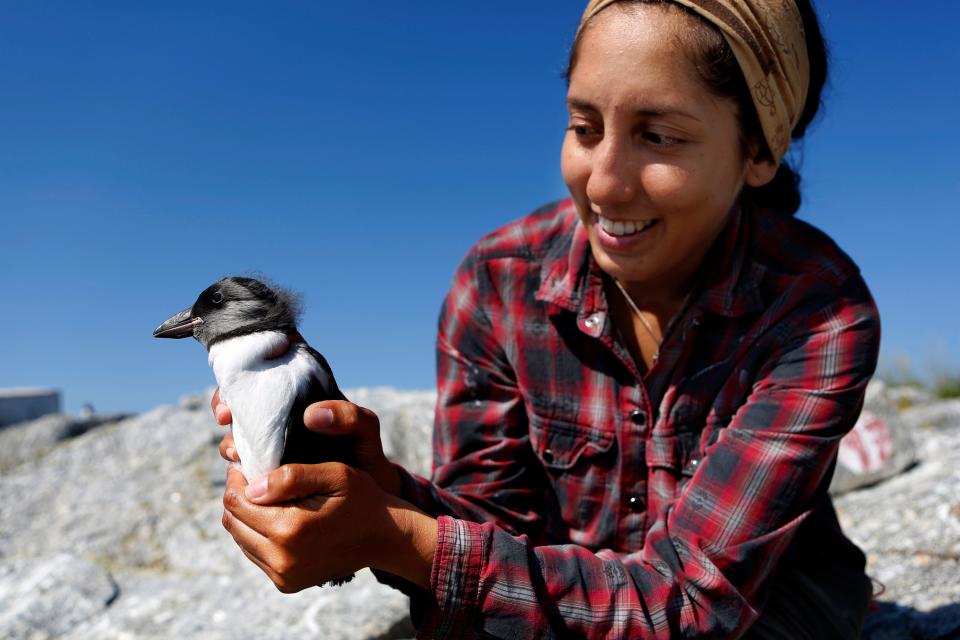Getting ready: Climate change and its effects on birds
They are among us every day, leading parallel lives, so unassuming that we sometimes fail to notice their beauty and grace. We absorb their chirps and quacks and songs and take for granted their contributions to our lives.
Without birds our mornings would be silent, our farms, forests and wetlands barren, our compact with nature broken. Nevertheless, destruction of bird habitats and stresses on species reproduction are part of the long list of calamitous results of climate change.
As subjects, birds are easy to watch and thus available for study as indicators of climate change. They carry out all sorts of tasks that benefit humans: pest control, seed dispersal, pollination.
The bird population in the Western Hemisphere is impressive. There are 3,445 species in South America, 1,230 in Central America, 2,059 in North America and 464 species In Maine.
Late autumn birdwatching: Birders say you should look for these feathered friends
Maine is a top breeding ground in the United States, especially in coastal and offshore waters. Iconic species are Warblers, Snowy Owls, Atlantic Puffins and Chickadees.
Birds are harbingers – early predictors of change. Because of their ability to migrate more easily than other animals, many are better able to deal with a changing climate, at least for a while. But warmer temperatures change foliage and food sources, making bird habitats less hospitable, which inhibits reproduction and destroys safe areas for their young.
Climate change has still other effects on birds: it interferes with regulation of body temperature, especially during migration. Body temperature affects reproduction, timing of breeding and migration and reduces fitness and survival overall. Also, the new environment may not have sufficient food resources and be unsuitable in other ways. Birds may, for instance, lose the timing of their food supply.
The journal Science reported in September 2019 that the bird population in North America had lost 2.9 billion breeding adults since 1970. In search of cooler, safer places, hundreds of bird species moved north from South and Central America to the southern United States and eventually into northeast Atlantic states and southern Canada. Tragically, many could not adapt; many more may meet the same fate.

National Geographic Society research teams report that if temperature rise isn’t slowed it will rise by 3 degrees centigrade by 2200, resulting in the loss of range for more than two-thirds of bird species. Some are already migrating to far northern Canada, where they are unlikely to survive. There is concern also that a massive migration of waterfowl is now headed to the Northeast from southern climates and may not find suitable habitat. With additional temperature rise many hundreds more species will lose their range and their ability to reproduce, and thus will become extinct, according to the National Audubon Society.
Birding paradise: Half of all bird species in Maine spotted at Sanford Lagoons
These same studies showed that if we could keep global temperature increases to 1.5 degrees centigrade “vulnerability would be reduced for 76% of North American species, and 38% of vulnerable species would no longer be vulnerable at all.”
Even so, many birds here in York County are susceptible to temperature rise, including the Black Duck, Green-winged Teal, Common Eider, Swamp Sparrow, Spotted Sandpiper, Piping Plover, Dark-eyed Junco, Scarlet Tanager, Bobolink, Wood Thrush, and Great Cormorant. Others, such as Bicknell’s Thrush, have already moved on.
Birds lose ground not only because of rising temperatures and sea levels but also to growing human populations and forest clearing. Still, if we can hold temperature rise at 1.5 degrees centigrade, the Maine birds named above and dozens of others could spring back and retake enough of their natural habitat to recover and thrive. If we fail, many species will lose at least half their range and/or be forced to move to other areas. Hundreds of other species likely will be lost.
We find this outlook unacceptable, yet we know it is true, for now. We are not helpless. Together we confront the situation with strength in numbers and economic influence. The key to a healthier climate is our ability to restrict the production and use of fossil fuels by the choices we make – at home, at work, the cars we drive, how we shop and travel, heat our homes and water and lead our lives, reducing and even eliminating our use of fossil fuels. Let’s all work together to protect the futures of our families, our town, and our planet and all its creatures.
York Ready for Climate Action is a grassroots citizens’ organization dedicated to building sustainability and reducing the causes of climate change and its effects on humans and the natural world. For more information see yorkreadyforclimateaction.org or info@yorkreadyforclimateaction.org. Information about EcoHOMES, a YRCA project, is at the same site.
This article originally appeared on Portsmouth Herald: Getting ready: Climate change and its effects on birds

